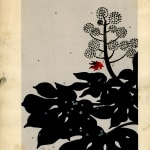








Hisui Sugiura
Hisui Kacho Zuan-shu, 1917
Bound collection of woodblock prints on paper
12-1/2”h x 9-1/4”w
Further images
-
(View a larger image of thumbnail 1
)

-
(View a larger image of thumbnail 2
)

-
(View a larger image of thumbnail 3
)

-
(View a larger image of thumbnail 4
)

-
(View a larger image of thumbnail 5
)

-
(View a larger image of thumbnail 6
)

-
(View a larger image of thumbnail 7
)

-
(View a larger image of thumbnail 8
)

-
(View a larger image of thumbnail 9
)

The work by Hisui Sugiura is one of the works that show us the big cultural change at this time. We experienced many cultural changes through westernization due to the...
The work by Hisui Sugiura is one of the works that show us the big cultural change at this time.
We experienced many cultural changes through westernization due to the Meiji Restoration (1868). One notable change concerning Zuancho involves three categories of beauty; fine art, design, and craft. There is a hierarchy among them in the West, which we did not have. The fact that we didn’t have this distinction means we also did not have words for them. Thus, the government hurriedly coined three words to help them join the western world. The reason for this absence of distinction will be an interesting discussion for another time.
When design started to have its own category, it certainly affected the course of Zuancho. Soon we saw “professional designers” create Kimono textile designs. Initially, these professional designers were either painters who needed fast cash to pay the bills or dyers, embroiderers, or weavers. They became in-house creators in the kimono industry by selling their designs to the publishers of Zuancho. With this change, Zuancho slowly spread to Tokyo. When they reached Tokyo, something remarkable happened that coincided with the beginning of the decline of the Kimono and its industry.
Graphic Design pattern books with woodblock printed pages, done in the same fashion as Zuancho, began to be published. Their designs were not for Kimono textile but publications and others. Since then, graphic design has developed exponentially with many other influences into the concept we are familiar with today.
with this Sugiura's work, we are looking at the beginning of modern graphic design in Japan. Many design-oriented works, such as Rinpa school paintings or Ukiyo-e prints, were created in the past. However, artists were not conscious of creating designs. Instead, the new breed of creators, such as Hisui or Kajita, were aware that they were designers. I believe this awareness was the engine of growth in Japanese design.
The condition of this book is not ideal, especially the margins of the prints. The printed parts have far fewer imperfections. The set is complete without any missing pages. It is priced reflecting the condition.
We experienced many cultural changes through westernization due to the Meiji Restoration (1868). One notable change concerning Zuancho involves three categories of beauty; fine art, design, and craft. There is a hierarchy among them in the West, which we did not have. The fact that we didn’t have this distinction means we also did not have words for them. Thus, the government hurriedly coined three words to help them join the western world. The reason for this absence of distinction will be an interesting discussion for another time.
When design started to have its own category, it certainly affected the course of Zuancho. Soon we saw “professional designers” create Kimono textile designs. Initially, these professional designers were either painters who needed fast cash to pay the bills or dyers, embroiderers, or weavers. They became in-house creators in the kimono industry by selling their designs to the publishers of Zuancho. With this change, Zuancho slowly spread to Tokyo. When they reached Tokyo, something remarkable happened that coincided with the beginning of the decline of the Kimono and its industry.
Graphic Design pattern books with woodblock printed pages, done in the same fashion as Zuancho, began to be published. Their designs were not for Kimono textile but publications and others. Since then, graphic design has developed exponentially with many other influences into the concept we are familiar with today.
with this Sugiura's work, we are looking at the beginning of modern graphic design in Japan. Many design-oriented works, such as Rinpa school paintings or Ukiyo-e prints, were created in the past. However, artists were not conscious of creating designs. Instead, the new breed of creators, such as Hisui or Kajita, were aware that they were designers. I believe this awareness was the engine of growth in Japanese design.
The condition of this book is not ideal, especially the margins of the prints. The printed parts have far fewer imperfections. The set is complete without any missing pages. It is priced reflecting the condition.
Signup for our Newsletter
You will receive two emails a month from us. One introduces artworks and design works from Kyoto's hidden sources and the other is stories from Misako, sharing insights into Japanese culture.
* denotes required fields
为了回应您的查询,我们将根据我们的隐私政策处理您提供的个人数据。